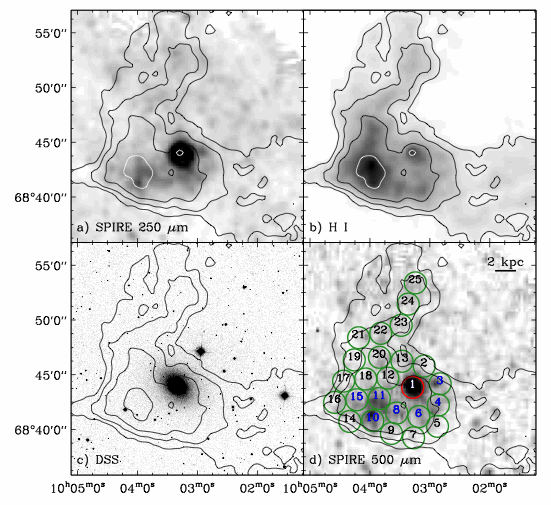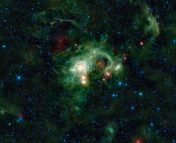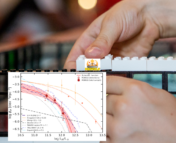
I am a first-year PhD candidate at York University in Toronto, Ontario. My primary research focus is on the transport and storage of volatile molecules like water on the Moon. I am also a member of the Environmental Science team on the Mars Science Laboratory Curiosity rover mission, where I study the properties of clouds that the rover observes over its landing site in Gale Crater.
Title: Distribution of Interplanetary Dust Detected by the Juno Spacecraft and Its Contribution to the Zodical Light
Authors: John L. Jørgensen, Mathias Benn, Jack E. P. Connerney, et al.
First Author’s Institution: National Space Institute, Technical University of Denmark,
Kongens Lyngby, Denmark
Status: Published in JGR Planets [open access]
The night sky is not completely dark. Anyone who has lived near a city is well-acquainted with this fact thanks to the ever-growing problem for astronomers that is light pollution. However, even in the most optimal of observing conditions, (including if you’re not located on Earth’s surface), the sky still isn’t perfectly dark! Our Solar System is full of interplanetary dust, which can scatter sunlight back towards you if you’re facing away from the Sun. This phenomenon manifests itself in the sky as the Zodiacal Light, a band of diffuse light centred on the ecliptic (the path that the Sun appears to take across the sky over the course of a year).
The origin and spatial distribution of the dust responsible for the Zodiacal Light is not well understood due to the small sizes of the dust particles and the fact that there simply are not many of them per unit volume of interplanetary space. Active comets and collisions between asteroids have both been proposed as mechanisms by which this dust is produced, but there simply isn’t enough data to definitively prove or disprove either of these theories. The authors of this paper present an analysis of data collected by the Juno spacecraft on its voyage through interplanetary space on its way to Jupiter that suggest an alternate source of dust: Mars.
A Serendipitous Discovery
Juno was not outfitted to detect interplanetary dust, unlike other missions like Pioneer 10 and 11, Galileo, and Cassini. However, its scientific payload did include four “star tracker”
cameras that are used to determine the spacecraft’s orientation by finding the relative locations of known star patterns. During the nearly five-year voyage to Jupiter, these cameras also observed a number of unusual bright streaks that appeared to originate extremely close to the spacecraft. The streaks were eventually identified as tiny pieces of the spacecraft body – mainly the 60 square metres of solar panels – that were being torn off by impacts with dust particles travelling at velocities between 5 and 15 kilometres per second. By measuring the frequency of these impact events, it is possible to determine the relative density of dust particles along the spacecraft’s flightpath.
As is often the case with missions to the outer Solar System, Juno wasn’t launched into an orbit that would take it directly to Jupiter. As shown in Figure 1, Juno’s trajectory can be broken into two sections. Initially, Juno was placed into an orbit in the plane of the ecliptic that would take it out beyond the orbit of Mars. It then travelled back towards the Sun and performed an Earth gravity assist that tilted its orbit by 4.5◦ and set it up to encounter Jupiter. This orbital configuration meant that Juno was able to sample the interplanetary dust at both a range of horizontal distances away from the Sun and a range of vertical distances away from the plane of the ecliptic.
In Figure 2, the rate of impact events is plotted against radial distance from the Sun. There are several interesting patterns that can be seen here. First, the dust seems to be largely confined to the region between Earth’s orbit and the edge of the Main Asteroid Belt, as the impact rates dropped dramatically as soon as Juno left the Asteroid Belt (see the bottom panel of Figure 2). Second, the dust is more abundant in the plane of the ecliptic than out of it, with impact rates decreasing by approximately one-half following Earth flyby (compare the “in ecliptic” rates in the top panel of Figure 2 with the “out of ecliptic” rates in the moddle panel). Finally, the dust abundance appears to be strongly influenced by Jupiter’s gravity, as can be seen by the sharp drops in impact rate that were observed near the 5:1 and 4:1 orbital resonance points (seen in the top panel of Figure 2). At the orbital resonance points, regular, repeated interactions with Jupiter’s gravitational field will eventually eject the dust from orbit.
Consequences for the Nature of Interplanetary Dust
Based on these results, the authors developed a model for the structure of the interplanetary dust population, which can be seen in Figure 3. It consists of a primary population, centered on Mars and extending between Earth’s orbit and the 4:1 Jupiter resonance point, and a secondary population composed of dust scattered out of the ecliptic plane by gravitational effects. The authors then determined what the Zodiacal Light would look like if it was produced by their modeled population and found that it closely follows actual observations.
The authors believe that the primary dust population being centered on Mars is more than a coincidence – they conclude that the dust has actually been lifted off the Martian surface and into interplanetary space. This hypothesis is supported by the fact that the 4:1 Jupiter resonance acts like a wall that prevents dust from migrating into or out of the Inner Solar System. Any dust that tries to cross the resonance line will be gravitationally ejected, implying that the source of all the interplanetary dust must lie on the same side of the 4:1 resonance as the dust itself. Because the modeled dust population and the Main Asteroid Belt are on opposite sides of the 4:1 resonance, the dust was probably not created by asteroidal interactions. The only object on the correct side of the resonance that could plausibly produce this much dust is Mars, so it is adopted as the most likely source.
This theory is not perfect, which the authors do acknowledge. They cannot explain how Martian dust would achieve the 5 kilometers per second velocity required to escape the Martian gravity well. Mars’ moons Phobos and Deimos could be an alternate source as they have much lower escape velocities (< 12 m/s), but any dust ejected from the small satellites would be trapped in Mars orbit. It is also not clear if the two moons would be able to supply enough mass to prevent the dust population from depleting over time.
Finally, the authors point out that the effect of these dust impacts should be carefully considered when designing future solar-powered interplanetary missions. The solar panels used by Juno and other similar missions were largely protected from serious damage by the robust nature of the materials to which the solar panels were mounted. Future missions that plan to use lighter (and thus cheaper) flexible solar panels may be more vulnerable to high-velocity impacts when traveling through the dust population proposed in this paper.
Image Credit: NASA/JPL-Caltech
This post was edited by Alice P. Curtin




